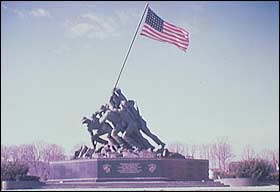|
 |
 |
The Jefferson Memorial surrounded by spring cherry blossoms. The memorial to the third President of the United States is located on the Tidal Basin in Washington, D.C.
Credit: Jeff Tinsley
|

 |
 |
Iwo Jima Memorial.
Credit: Library of Congress, Prints & Photographs
Division, Theodor Horydczak Collection
|
|
 |
 |
| Original flyer for 1963 March
on Washington. |
|
|

|
|
THE MALL: 1940-1980
When Union leader A. Philip Randolph organized a March on Washington movement in 1941 to protest discrimination in war industries, the powerful image of the crowds at the Marian Anderson "Freedom Concert" was on everyone's mind. The March was called off when President Roosevelt's response to the possibility of a March was the executive order establishing the fair Employment Practices Committee.
While the power of marching on Washington was just beginning to be an idea, monumental Washington continued to be built. In 1943 a new memorial was added to the Mall. The Thomas Jefferson Memorial, designed by Alexander Pope, continued the neo-classical style established by the McMillan Plan and the Lincoln Memorial. The personalities of major American presidents continued to be the medium for communicating American history on the Mall. The next major national memorial contemplated for the capital was the Iwo Jima Memorial. It was first proposed for the Mall site, but the final location was near Arlington Cemetery in Virginia. Dedicated in 1946, it is a sculptural grouping of soldiers hoisting the American Flag at Iwo Jima. Sculptor Felix DeWelden based the statue on Associated Press photographer Joe Rosenthal's photograph taken at the Iwo Jima battle.
The importance of the Mall as a site for national protest as well as
national commemoration came into its own in 1963. The 1963
March on Washington proved to be a major turning point in the history
of the Mall and its use by American citizens for political protest. Bayard
Rustin was the chief organizer and logistics person for the 1963 March
on Washington for Jobs and Freedom. Rustin was largely responsible for
organizing an orderly and peaceful demonstration. It was at Rustin's urging
that A. Philip Randolph called for the march that culminated in the historic
"I Have a Dream" speech by Dr. King. The March was supported by a broad
coalition of black organizations, as well as the Protestant National Council
of Churches, the National Conference of Catholics for Interracial Justice,
the American Jewish Congress, and the AFL-CIO Industrial Union Department.
The March on Washington brought together a peaceful gathering of approximately
250,000 black and white demonstrators.
The 1963 March sparked a growing use of the Mall grounds for protest.
With anti-war sentiment growing throughout the 1960's the Mall became
a site for massive demonstrations. Students for a Democratic Society sponsored
the first major anti-war rally in Washington, D.C. on April 17th, 1965.
Every year from 1967-1971, a major anti-war march occurred in the district,
including four of the biggest anti-war
demonstrations in American history. After the war, demonstrations
continued to be held in the capitol. The 1970's saw a number of mass demonstrations
for women's rights, including the 1978
March for Equality in support of the Equal Rights Amendment. The 100,000
demonstrators made this the largest demonstration in feminist history.
Next: The Modern Mall: 1980-Present »
« Previous: The Mall: 1901-1940
|